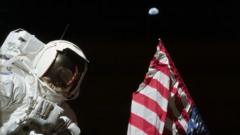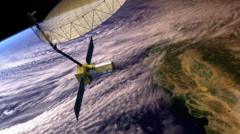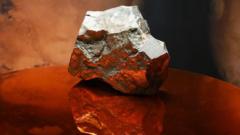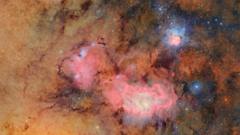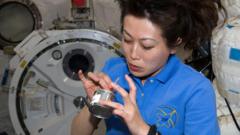**Firefly Aerospace's Blue Ghost marks a significant milestone in commercial space travel, successfully landing on the Moon and opening new avenues for lunar exploration.**
**Commercial Success: Blue Ghost Successfully Lands on the Moon**
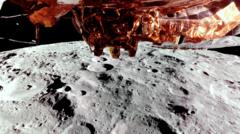
**Commercial Success: Blue Ghost Successfully Lands on the Moon**
**Private Spacecraft Makes Historic Touchdown, Boosting Lunar Exploration Efforts**
In a landmark achievement for private space travel, Blue Ghost, a spacecraft developed by Firefly Aerospace, has successfully landed on the Moon, becoming just the second commercial vehicle to reach the lunar surface. Launched on January 15, Blue Ghost's mission aimed to explore the Sea of Crises, a massive crater visible from Earth.
The venture represents a growing collaboration between NASA and private firms, aimed at reviving interest in lunar exploration. Intuitive Machines, a competing firm that previously achieved a lunar landing with its Odysseus spacecraft on February 22 last year, is also working on a mission to deploy its Athena spacecraft close to the Moon's south pole in the coming days.
Unlike Intuitive Machines, which suffered a setback when Odysseus landed on a slope and toppled over, Blue Ghost executed a smooth landing after orbiting the Moon for two weeks. The successful touchdown prompted cheers from employees at Firefly's Texas headquarters, marking a proud moment for the company.
Dr. Simeon Barber, a planetary science researcher from Open University, highlighted the significance of Blue Ghost's success, calling it the "first successful private venture" to the Moon due to its intact status following the landing. The mission showcases renewed technology and capabilities that have been largely dormant since the Apollo era and may prove crucial not only for lunar exploration but also as a preparatory phase for future missions to deeper space.
Furthermore, Dr. Barber emphasized the Moon's potential as a springboard for robotic and human exploration, underscoring that repeated lunar missions could pave the way for understanding and managing resources in the harsh lunar environment, including navigating extreme temperatures, dust, and radiation.
Historically, human landings on the Moon have been infrequent, with the last crewed mission occurring during Apollo 17 on December 19, 1972. Barber pointed out that the overwhelming costs associated with such missions have limited human landings, which typically lasted only three days. In contrast, the shift toward private enterprise may drive down costs, offering innovative solutions and opportunities for resource extraction on the Moon.
In another case of commercial competition, Astrobotic Technology attempted a lunar landing with their own spacecraft in January 2024, but unfortunately, it failed due to a fuel leak, resulting in a crash back to Earth, enveloped in flames upon descent.
As Blue Ghost marks a new dawn for private lunar missions, it promises to usher in a renewed era of exploration, collaboration, and potential resource utilization on the Moon.
The venture represents a growing collaboration between NASA and private firms, aimed at reviving interest in lunar exploration. Intuitive Machines, a competing firm that previously achieved a lunar landing with its Odysseus spacecraft on February 22 last year, is also working on a mission to deploy its Athena spacecraft close to the Moon's south pole in the coming days.
Unlike Intuitive Machines, which suffered a setback when Odysseus landed on a slope and toppled over, Blue Ghost executed a smooth landing after orbiting the Moon for two weeks. The successful touchdown prompted cheers from employees at Firefly's Texas headquarters, marking a proud moment for the company.
Dr. Simeon Barber, a planetary science researcher from Open University, highlighted the significance of Blue Ghost's success, calling it the "first successful private venture" to the Moon due to its intact status following the landing. The mission showcases renewed technology and capabilities that have been largely dormant since the Apollo era and may prove crucial not only for lunar exploration but also as a preparatory phase for future missions to deeper space.
Furthermore, Dr. Barber emphasized the Moon's potential as a springboard for robotic and human exploration, underscoring that repeated lunar missions could pave the way for understanding and managing resources in the harsh lunar environment, including navigating extreme temperatures, dust, and radiation.
Historically, human landings on the Moon have been infrequent, with the last crewed mission occurring during Apollo 17 on December 19, 1972. Barber pointed out that the overwhelming costs associated with such missions have limited human landings, which typically lasted only three days. In contrast, the shift toward private enterprise may drive down costs, offering innovative solutions and opportunities for resource extraction on the Moon.
In another case of commercial competition, Astrobotic Technology attempted a lunar landing with their own spacecraft in January 2024, but unfortunately, it failed due to a fuel leak, resulting in a crash back to Earth, enveloped in flames upon descent.
As Blue Ghost marks a new dawn for private lunar missions, it promises to usher in a renewed era of exploration, collaboration, and potential resource utilization on the Moon.


